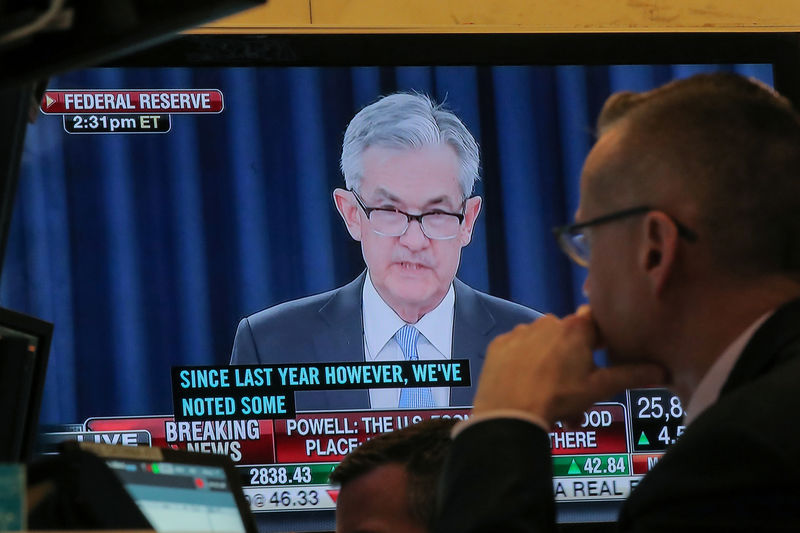(Bloomberg) -- After Federal Reserve Chair Jerome Powell spent two days telling U.S. lawmakers the economy is in no state to be thinking about monetary tightening, financial markets on Thursday suddenly started pricing in a rapid -- and perhaps too-hot -- recovery.
The axis of tension is the new policy framework the Fed put in place last year. It dictates the central bank won’t raise interest rates early on in the recovery and will intentionally overshoot its 2% inflation target -- maybe for years, while testing the limits of a hot jobs market.
Evidence in the $21 trillion U.S. government bond market suggests some investors just don’t believe it. Short-dated rates signal a Fed hike coming in around two years. Yields on intermediate to long-dated maturities are surging -- suggesting a rapid reflation that spurs the Fed to pull back on stimulus.
In the market bleachers, some big names in economics, including Harvard University economist Lawrence Summers and former IMF chief economist Olivier Blanchard, are warning of economic overheating from the $1.9 trillion stimulus bill President Joe Biden aims to sign next month.
With yields heading for the biggest monthly surge since November 2016, the threat of higher borrowing costs sent U.S. equities tumbling. Sustained moves would likely force a response, Fed watchers said, such as shifting their bond purchases to longer-dated maturities.
“It is really incumbent on Powell to demonstrate resolve. It is going to take a lot of courage and I don’t know how he is going to do under pressure,” said Derek Tang an economist at LH Meyer Inc., a Washington research firm. “This is the first test of the framework” adopted last August, he said.
Before Thursday’s leg higher, Fed Vice Chair Richard Clarida said markets are “pricing in a better outlok for the U.S. economy” and saw in that a sign of “credibility of our 2% inflation objective.” He said he sees the Fed keeping its $120 billion in monthly bond purchases going through year-end.
And in his semiannual testimony on the economy, Powell reinforced on Tuesday that the Fed aims to overshoot its 2% target and told progressive Democrats repeatedly that he was on the same page with them in aiming for a tight labor market that pulls in low-income and disadvantaged workers. He called the rise in bond yields a sign of confidence.
But there’s a fine line between the yield curve manifesting investor confidence in the recovery and it signalling concern that the economy could overheat and force policy makers to reverse tack much sooner than they plan to. Derivative traders have pulled forward to about early-2023 from early-2024 when they foresee the first Fed rate hike. Five-year Treasury yields have surged along with longer-dated ones this week.
Meantime, expectations for inflation over the next decade -- derived from Treasuries and inflation-linked debt -- is near its highest since 2014, speaking to a more-than-transitory pick-up in inflation. And real yields -- a gauge of economic growth expectations, as they filter out consumer-price expectations -- have also soared, though from historically depressed levels.
Fed officials have stressed repeatedly that even if prices do jump in coming months, it’s likely to prove transitory. The more important goal for policy makers is employment, with 10 million people out of work compared with the pre-pandemic level.
New Era
“The new framework is being put to work,” Julia Coronado, founder of MacroPolicy Perspectives LLC, said of the Fed’s determination to make up for past undershoots of its inflation target. “Not everybody outside the Fed appreciates how deeply it is sinking into their thought processes,” she said.
But for all Powell’s calls to look at the reality on the ground, the Fed has been surprised in the past at just how fast market tantrums can run. A selloff in the stock market in late 2018 prompted a memorable Powell pivot in January 2019, when the central bank took further tightening off the table. By the end of that year, policy makers cut rates three times.
While Fed speakers have so far indicated no concern -- a notable contrast with counterparts abroad -- their tune may change.
“I wouldn’t be surprised if we see the Fed push back against those rate-hike expectations in the form of stronger verbiage,” said Roberto Perli, a partner at Cornerstone Macro LLC and a former Fed economist, referring to traders’ bets for an earlier withdrawal of Fed stimulus. “To ensure the credibility of the new framework, I don’t think they want to let the market push them with rate hikes priced in too soon.”
Fed’s Options
The Federal Open Market Committee may also have to find ways to signal more specifically it means by “substantial further progress” toward its inflation and employment goals before it begins to taper asset purchases.
Another option: lean directly against rising bond yields by targeting longer maturities with the Fed’s $80 billion in monthly Treasury purchases.
What can still give the Fed comfort is that financial conditions remain extremely easy.
A change on that front would cement the need for a policy-maker reaction, however. It all depends on how the market move proceeds.“Once it takes stocks materially lower, takes credit spreads materially wider then there will be push-back from the Fed,” said Peter Chatwell, London-based head of multi-asset strategy for Mizuho International Plc. “The room for an additional correction -- with even higher intermediate Treasury yields and lower risk-asset prices -- is considerable, because it can keep happening until the Fed” takes action, he said.
©2021 Bloomberg L.P.
